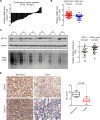Loss of GFAT1 promotes epithelial-to-mesenchymal transition and predicts unfavorable prognosis in gastric cancer
- PMID: 27509259
- PMCID: PMC5122401
- DOI: 10.18632/oncotarget.9538
Loss of GFAT1 promotes epithelial-to-mesenchymal transition and predicts unfavorable prognosis in gastric cancer
Abstract
Gastric cancer remains the third leading cause of cancer-related mortality worldwide, and invasion and metastasis of gastric cancer represent the major reason for its poor prognosis. Glutamine: fructose-6-phosphate amidotransferase 1 (GFAT1) is the first and rate-limiting enzyme of hexosamine biosynthesis pathway (HBP). Nevertheless, the role of GFAT1 in gastric cancer is little investigated. In this study, we found that the expression of GFAT1 was decreased in gastric cancer. Low expression of GFAT1 was positively associated with vessel invasion, late T stage, lymph node metastasis, distant metastasis, advanced TNM stage and poor prognosis in patients with gastric cancer. Furthermore, in vitro and in vivo studies revealed that down-regulation of GFAT1 promoted epithelial-to-mesenchymal transition (EMT) and invasive activities in gastric cancer cells through inducing the expression of TGF-β1. The GFAT1 expression also significantly correlated with EMT-related factors in gastric cancer patients. Together, these findings indicate that GFAT1 functions as a novel suppressor of EMT and tumor metastasis in gastric cancer.
Keywords: GFAT1; TGF-β1; epithelial-to-mesenchymal transition; gastric cancer; prognostic factor.
Conflict of interest statement
The authors declare no competing interests.
Figures





References
-
- Siegel R, Ma J, Zou Z, Jemal A. Cancer statistics, 2014. CA Cancer J Clin. 2014;64:9–29. - PubMed
-
- Torre LA, Bray F, Siegel RL, Ferlay J, Lortet-Tieulent J, Jemal A. Global cancer statistics, 2012. CA Cancer J Clin. 2015;65:87–108. - PubMed
-
- Ferlay J, Shin HR, Bray F, Forman D, Mathers C, Parkin DM. Estimates of worldwide burden of cancer in 2008: GLOBOCAN 2008. Int J Cancer. 2010;127:2893–2917. - PubMed
-
- Ferlay J, Steliarova-Foucher E, Lortet-Tieulent J, Rosso S, Coebergh JW, Comber H, Forman D, Bray F. Cancer incidence and mortality patterns in Europe: estimates for 40 countries in 2012. Eur J Cancer. 2013;49:1374–1403. - PubMed
-
- Washington K. 7th edition of the AJCC cancer staging manual: stomach. Ann Surg Oncol. 2010;17:3077–3079. - PubMed
MeSH terms
Substances
LinkOut - more resources
Full Text Sources
Other Literature Sources
Medical
Miscellaneous

